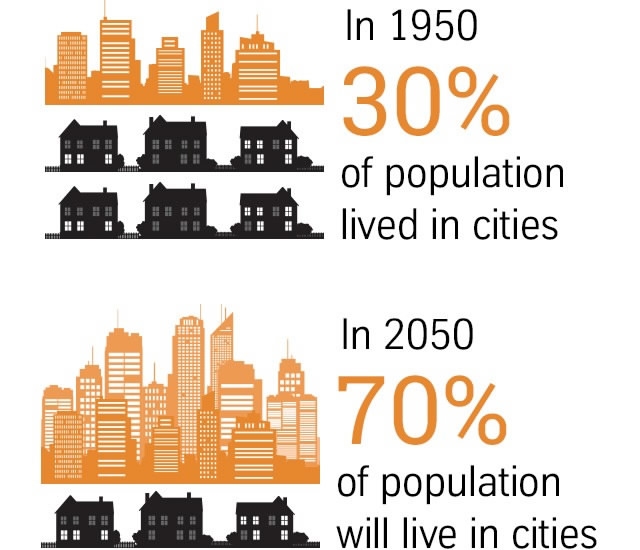
Business
10:30, 09-Nov-2017
A model for urbanization: China’s city clusters
By Han Jie

Top of the agenda for this year’s Asian-Pacific Economic Cooperation (APEC) is the process of urbanization and its role in developing the regional economy.
The summit, which started on Monday in Vietnam, has implemented a policy of "Five Nos" and "Three Haves," with the “haves” referring to the goal of people having houses, jobs and urban civilized lifestyle.
With the population shift from rural to urban areas, urbanization can seem a necessary path toward modernization as well as a key engine for sustainable economic growth.

CGTN Photo
CGTN Photo
Working to connect the region through improving physical infrastructure linkages, mobility and institutional ties, APEC is also working to ensure all members can participate in the growing economy by learning from other regions.
Chinese model of urbanization
In China, more than 80 million people – about 57 percent of the Chinese population are currently living in cities. As the world's second-largest economy, China continued its firm growth in the first three quarters of this year, with gross domestic product expanding 6.9 percent year-on-year to 59.3288 trillion yuan (about 8.9614 trillion US dollars), the National Bureau of Statistics report shows.
Although China’s extraordinary economic boom has gone hand-in-hand with urbanization, it has led to a sharp increase in consumer and investment demand, and huge needs in infrastructure, public service and housing.

VCG Photo
VCG Photo
According to a recent report published by the Ministry of Human Resources and Social Security (MHRSS), the registered unemployment rate in Chinese cities stood at 3.95 percent at the end of the third quarter, the lowest level since 2008.
China’s urbanization program is an important part of structural reform, as the nation transitions to a more productive, service-based economy. General Secretary Xi Jinping stressed the importance of developing city clusters – coordinated regional development and urbanization – at the 19th National Congress of the Communist Party of China this year, mentioning that China's urbanization is at a crucial juncture, and it now needs to focus on these clusters.
In order to combat the sluggish global economic recovery and rising challenges and risks, urbanization in the Asia-Pacific economies needs to not only drive market demand but can also help achieve wider coverage of public services, enhanced food security, better environmental protection, narrower urban-rural gaps and inclusive economic growth.

VCG Photo
VCG Photo
Xiongan New Area
Like China’s urbanization plan, it has been upgraded from individual cities and provinces to world-class city clusters, according to the 19th CPC National Congress.
In an ideal city cluster, big cities are connected with each other by inter-city railways, expressways and other transport means, which also connect them with nearby smaller towns. In the Xiongan New Area, the coordinated development of Beijing, Tianjin and Hebei Province is a national strategy that aims to create a world-class city cluster in northern China.

The Xiongan New Area, the coordinated development of Beijing, Tianjin and Hebei Province is a national strategy that aims to create a world-class city cluster in northern China. /CGTN Photo
The Xiongan New Area, the coordinated development of Beijing, Tianjin and Hebei Province is a national strategy that aims to create a world-class city cluster in northern China. /CGTN Photo
Compared with the Yangtze River and the Pearl River Deltas, where the coordination and integration levels are much higher, the Xiongan New Area will integrate the economies of the Beijing-Tianjin-Heibei region into the megaregion Jing-Jin-Ji. The region is designed to hold 110 million people and merge outer parts of the three areas in order to break down "fortress economies" in the region.
He Lifeng, director of China’s national development and reform commission, said in March that Jing-Jin-Ji would help distribute wealth that had been sucked into Beijing to the areas surrounding the capital – many of which are still impoverished villages.
Urbanization and Chinese supply-side reform
With corporate universities, institutions and residents from the capital, helping to alleviate pressure on housing and public services, the Jing-Jin-Ji area hopes to strengthen the coordination of local governments and provide integrated public services to locals.

CGTN Photo
CGTN Photo
The integrated development of urban and rural areas is expected to generate investment and consumption of nearly 100 trillion yuan, which "will be the most remarkable bonus for China's development in the medium to long run," said Chi Fulin, head of the China Institute for Reform and Development.
While gains from structural reforms will take time, they will have a positive impact on China's economic growth in the medium term, said Changyong Rhee, director of the Asia Pacific Department at the IMF, adding that China's growth has also provided ample opportunities for Asia to maintain its growth over the last 10 years.
From field to the office, China's high efficiency in decision-making and execution means it can mobilize the necessary resources in a short time to foster world-class urban clusters.
1km

SITEMAP
Copyright © 2018 CGTN. Beijing ICP prepared NO.16065310-3
Copyright © 2018 CGTN. Beijing ICP prepared NO.16065310-3